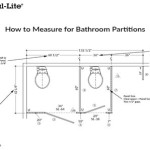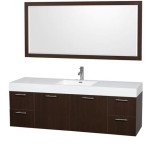Bathroom Sink Mounting Clips: A Comprehensive Guide
Bathroom sinks are integral components of any bathroom, serving both functional and aesthetic purposes. Maintaining their stability and secure attachment to countertops or walls is paramount. This is where bathroom sink mounting clips play a crucial role. These seemingly small pieces of hardware are responsible for providing the necessary support and preventing movement or potential damage to the sink and surrounding surfaces. Understanding the types, functions, and proper installation techniques of these clips is essential for ensuring a long-lasting and reliable bathroom sink installation.
Different types of bathroom sinks require specific mounting solutions. Undermount sinks, for instance, necessitate clips designed to grip the underside of the countertop and pull the sink upwards. Overmount or drop-in sinks, on the other hand, may utilize clips that secure the sink rim to the countertop from above or below. The material of the sink, the countertop material, and the desired aesthetic all influence the selection of the appropriate mounting clips.
Failure to use the correct mounting clips or improper installation can lead to a variety of problems. A loose sink can be prone to leaks, causing water damage to the surrounding cabinetry and flooring. The movement can also weaken the bond between the sink and the countertop, eventually leading to the sink detaching completely. Choosing high-quality mounting clips and following proper installation procedures are therefore critical for preventing these issues and ensuring the longevity of the bathroom sink installation.
Choosing the Right Type of Mounting Clip
The selection of appropriate bathroom sink mounting clips is not a one-size-fits-all process. Several factors must be considered to ensure a secure and reliable installation. The type of sink is perhaps the most important determining factor. Each sink style is designed to be mounted in a specific way and will require a compatible clip design.
Undermount Sink Clips: These clips are specifically designed for undermount sinks, which are installed beneath the countertop. They typically consist of a bracket that attaches to the underside of the countertop, a threaded rod or screw, and a tightening mechanism. The clip grips the edge of the sink from below, pulling it upward against the countertop. The tightening mechanism allows for fine-tuning the pressure and ensuring a snug fit. Undermount sink clips are often adjustable to accommodate variations in sink thickness and countertop overhang. The number of clips required will depend on the size and weight of the sink, with larger sinks requiring more clips for adequate support.
Overmount/Drop-in Sink Clips: Also referred to as top-mount sinks, these sinks are designed to sit on top of the countertop. The rim of the sink rests on the cutout in the countertop, and clips are used to secure it in place. These clips can be installed from above or below the countertop. Top-mounted clips typically feature a hook or flange that engages with the sink's rim, preventing it from shifting. Bottom-mounted clips for overmount sinks work similarly to undermount clips, applying upward pressure to the sink from beneath the countertop. The choice between top-mounted and bottom-mounted clips often depends on the accessibility of the underside of the countertop and the desired aesthetic. Some overmount sinks may have pre-drilled holes in the rim for specific clip designs.
Vessel Sink Mounting Rings and Clips: Vessel sinks sit entirely on top of the countertop, resembling a bowl. They often utilize a mounting ring or a specialized clip system to secure them. Mounting rings are typically circular or oval-shaped and are installed between the sink and the countertop. They provide a stable base and prevent the sink from rocking or tipping. Clips for vessel sinks may be used in conjunction with a mounting ring or as a standalone securing mechanism. These clips often attach to the underside of the countertop and provide lateral support to the sink.
Beyond the sink type, the countertop material also plays a role in clip selection. Stone countertops, such as granite or marble, are less susceptible to damage from overtightening compared to laminate or solid surface countertops. When working with delicate countertops, it is crucial to choose clips with adjustable tension and avoid excessive pressure. The weight of the sink is another important consideration. Heavier sinks require stronger and more numerous clips to ensure adequate support. Always refer to the sink manufacturer's recommendations for the appropriate type and number of mounting clips.
Materials and Durability of Mounting Clips
The materials used in the construction of bathroom sink mounting clips significantly impact their durability and resistance to corrosion. Considering the humid environment of a bathroom, selecting clips made from corrosion-resistant materials is crucial for ensuring a long lifespan and preventing premature failure. Several materials are commonly used in the manufacturing of these clips, each offering its own advantages and disadvantages.
Stainless Steel: Stainless steel is a popular choice for mounting clips due to its excellent corrosion resistance. It is highly resistant to rust and degradation, even in humid environments. Stainless steel clips are also known for their strength and durability, providing reliable support for bathroom sinks. Different grades of stainless steel exist, with higher grades offering superior corrosion resistance. 304 stainless steel is a commonly used grade known for its good balance of strength and corrosion resistance. 316 stainless steel, also known as marine-grade stainless steel, offers even greater corrosion resistance and is ideal for environments with high humidity or exposure to saltwater.
Plated Steel: Steel clips can be plated with various materials to improve their corrosion resistance. Chrome plating is a common option, providing a shiny finish and a degree of protection against rust. However, chrome plating can be susceptible to scratches and chipping, which can expose the underlying steel to corrosion. Zinc plating is another option, offering better corrosion resistance than chrome plating. Zinc-plated clips are often used in applications where aesthetics is less of a concern. The thickness and quality of the plating significantly impact its effectiveness in preventing corrosion. Thicker plating provides better protection. Epoxy coating is another type of protective coating that can be applied to steel clips. Epoxy coatings are durable and resistant to chemicals, making them suitable for bathroom environments.
Plastic: Plastic clips are often used for lighter-weight sinks and in situations where metal clips could potentially damage the countertop material. While plastic clips are generally corrosion-resistant, their strength and durability are lower compared to metal clips. The type of plastic used significantly impacts its performance. High-density polyethylene (HDPE) and polypropylene (PP) are common choices for plastic mounting clips due to their resistance to moisture and chemicals. When using plastic clips, it is crucial to ensure they are adequately sized and rated for the weight of the sink.
When selecting mounting clips, it is important to consider the long-term consequences of using inferior materials. Choosing clips made from high-quality, corrosion-resistant materials is an investment that will pay off in the form of reduced maintenance, fewer repairs, and prolonged lifespan of the bathroom sink installation. Always inspect the clips for any signs of damage or corrosion before installation, and replace any questionable clips immediately.
Proper Installation Techniques for Mounting Clips
Even the highest-quality mounting clips will fail if they are not installed properly. Following the correct installation techniques is crucial for ensuring a secure and reliable bathroom sink installation. Before beginning the installation process, carefully read and understand the manufacturer's instructions for both the sink and the mounting clips. These instructions will provide specific guidance on the proper placement and tightening of the clips.
Preparing the Surfaces: Before installing the mounting clips, ensure that both the sink and the countertop surfaces are clean and dry. Remove any debris, dust, or grease that could interfere with the adhesion of the clips. For undermount sinks, thoroughly clean the underside of the countertop where the clips will be attached. Use a mild detergent and water to remove any residue. For overmount sinks, clean the rim of the sink and the countertop surface where the rim will rest. If the countertop is porous, consider applying a sealant to protect it from moisture damage.
Positioning and Securing the Clips: The correct positioning of the mounting clips is essential for providing adequate support to the sink. Distribute the clips evenly around the perimeter of the sink, ensuring that they are spaced appropriately. The manufacturer's instructions will specify the recommended spacing for the clips. For undermount sinks, carefully position the sink beneath the countertop and align it with the cutout. Attach the mounting clips to the underside of the countertop using screws or adhesive, depending on the clip design. Ensure that the clips are securely fastened and that they grip the edge of the sink firmly. For overmount sinks, place the sink rim onto the countertop cutout and align it properly. Attach the clips from above or below, depending on the clip type. Make sure the clips engage securely with the sink rim and the countertop.
Tightening and Adjusting the Clips: Once the clips are in place, gradually tighten them to secure the sink. Avoid overtightening the clips, as this can damage the sink or the countertop. Use a torque wrench to ensure that the clips are tightened to the manufacturer's recommended torque specifications. For undermount sinks, alternate between tightening the clips on opposite sides of the sink to ensure even pressure distribution. Regularly check the alignment of the sink as you tighten the clips. For overmount sinks, ensure that the sink rim is flush with the countertop surface. After tightening the clips, inspect the sink for any signs of movement or instability. If necessary, make minor adjustments to the clip positions or tightening torque to ensure a secure and stable installation. Allow any adhesive used in the installation process to fully cure before using the sink.
By following these proper installation techniques, a secure and long-lasting bathroom sink installation can be achieved. Remember to consult the manufacturer's instructions for specific guidance and to exercise caution when working with tools and adhesives.

Keeney 8 Piece Steel Universal Sink Mounting Clips In The Hardware Department At Com

Keeney 10 Piece Steel Kitchen Sink Mounting Clips In The Hardware Department At Com

American Standard 8 Piece Galvanized Steel Bathroom Sink Mounting Clips In The Hardware Department At Com

Undermount Sink Mounting Installation Clips U Bracket

10pcs Punch Free Kitchen Sink Mounting Clips Support Clamps Fixed For Com

Danco Sink Clips For Tile Counter 4 Pack 88488 The Home Depot

Chrome Bracket For Washbasins Brackets Supports Shelf Support Shelves Ledge En Suite Shower Room Wash Basin

Undermount Bathroom Sink Buyer S Guide The Family Handyman

Sink Clips Used For Mounting Sinks

Miseno Mno1812rubwh Cafe 21 X 15 Undermount Bathroom Build Com







